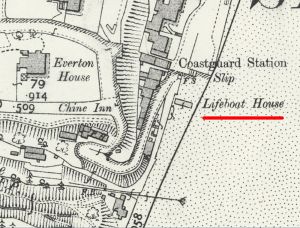Isle of Wight Sunday School Lifeboat
At the end of March 1868 a meeting was held at Newport, Isle of Wight, of Sunday School teachers, senior scholar, and friends from across the Island at which a committee was formed to raise the funds for a Isle of Wight Sunday School Lifeboat[1]. The idea had been initiated by Mr Henry King, of 40 Alexandra Terrace, Newport, a High Street fruiterer, after becoming aware that other groups, Sunday Schools, Society of Friends etc., across the county had raised funds from members for their own lifeboats. Mr. G. Sparks was a Sunday school teacher, local preacher and also foreman at ‘Mr. White’s dockyard’, where the lifeboat was expected to be built[2].
By June, the funding raising was progressing; the Newport Baptist’s School had raised about £12, the Ventnor schools £25, at Freshwater about £15, and at Langbridge [Newchurch], where the pupils numbered no more than forty, £1 7s 2d[3]. The final total cost was reputed to be £162[4].
The Isle of Wight Sunday Schools Lifeboat, a 29ft, Lamb & White type, was officially launched at Prince’s Green, West Cowes on 29 June 1868 – newspaper reports record that ‘steamers from Southampton, Portsmouth, Ryde, Yarmouth and Lymington poured in hundreds of people during the morning, and their numbers were augmented by large additions from various surrounding towns.’
A procession consisting of children from various Sunday Schools were followed by the band of the IW Artillery Militia and then came the lifeboat on her carriage drawn by 30 of the older boys and accompanied by her picked crew of six men. The procession formed up in Medina Road and proceeded along the High Street, Bath Road, across the Parade, up Castle Hill and along the upper road to the Green where they met a considerable crowd.
The Lifeboat was named “the Dove” by Miss Lucy Ward by breaking a bottle of wine across the Lifeboat’s bow. Following the naming, the ‘Dove’ was put to test – she was filled with water and ‘apparently remained as buoyant as ever’; while an ordinary boat of similar size was filled with water but had to be abandoned by its crew[5].
The ‘Dove’ was put on station at Yarmouth in 1868 and soon saw service.
In October 1868, the ‘Dove’ attended the Norwegian barque ‘Ino’ which had run aground on the Shingles, however, the barque managed to get off by herself and the services of the ‘Dove’ were not required[6]. However, the crew subsequently received a letter of thanks from G. T. Winther, Esq., the Swedish and Norwegian vice-consul at Cowes[7].
In 1870, the ‘Dove’ was moved to Totland as it was nearer potential hazards.
After the Royal National Lifeboat Institution (RNLI) placed a lifeboat at Totland in 1885, the ‘Dove’ was moved to Shanklin where, after the Eurydice disaster in 1878, it was consider that a lifeboat was necessary. At Shanklin a boathouse was built at the foot of Chine Hill.
November 1893 saw the SS Gripfast, a 502 ton steamer bound from Swansea to London with a cargo of coal founder off Ventnor after an explosion on board. The ‘Dove’ managed to reach the Gripfast and rescued the 14 surviving crew, and dog, and landed them at Ventnor[8].
Whit Monday in 1894 saw an ‘imposing procession’ in Newport and at Carisbrooke Castle of various lifeboats and their crews from around the Island. The ‘Dove’s was in the procession and her crew was recorded as S. Kemp (coxswain), William Blew (bowman), T. Rayner, G. Watson, A. Colenutt, H. Howlett, and E. Blew[9].
A ‘destructive storm’ struck the Island on 5th November 1916 and at Shanklin ‘the violent S.S.E. wind washed over the front, carrying away the lifeboat, with its house….’ as well as causing other damage in the area[10].
That was the end of the Isle of Wight Sunday School lifeboat, she was not replaced.
- ↑ Isle of Wight Observer - 4 April 1868
- ↑ Isle of Wight Observer - 11 April 1868
- ↑ Hampshire Independent – 6 June 1868
- ↑ The Lifeboat Service in England – South Coast ... by Nicholas Leach – Amberley Publishing - 978-1-4456-4645-9
- ↑ Hampshire Independent – 1 July 1868
- ↑ Hampshire Advertiser - 10 October 1868
- ↑ Hampshire Independent - 14 October 1868
- ↑ Isle of Wight County Press – 18 November 1893
- ↑ Isle of Wight County Press – 19 May 1894
- ↑ Isle of Wight County Press - 11 November 1916
